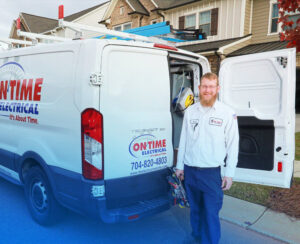 Imagine you’re sitting at home during a massive storm, and suddenly, BOOM! The power goes out. Your refrigerator stops humming, your heat or air conditioning shuts down, and you’re left in the dark (literally). Sound familiar?
Imagine you’re sitting at home during a massive storm, and suddenly, BOOM! The power goes out. Your refrigerator stops humming, your heat or air conditioning shuts down, and you’re left in the dark (literally). Sound familiar?
But you don’t need to stay there. Standby generators provide a reliable backup and automatic operation, cutting down the need for manual intervention during blackouts. This is exactly why they have become a homeowner’s best friend.
However, installing a standby generator is a highly technical process that requires expertise. If you need the help of licensed electricians, our team at Dependaworthy On Time Electrical in Charlotte, NC, are experts in generator installation and repairs. The best part? We can do it safely and right from the get-go.
Is Installing a Standby Generator a DIY Project?
Let’s start addressing the elephant in the room. You may be thinking: “Could I just install a standby generator myself?” The short answer: Nope. This isn’t a weekend DIY project. Installing a standby generator involves some seriously complicated electrical work, gas line connections, and navigating local building codes. One wrong move could mean electrical fires, gas leaks, or worse. Trust us, this is a job for the pros.
When you get the help of licensed electricians, you can trust that they handle these installations with precision. They also understand permitting requirements and local regulations. How about breathing easy and not worrying about safety or legal troubles?
If you’re in Charlotte, NC, Dependaworthy On Time Electrical is your go-to source for expert generator installation services.
What Exactly Are Standby Generators?
They are like a superhero for your home’s electricity. Unlike those clunky portable generators you might have seen, these are permanent systems that kick in automatically when the power drops. No more scrambling in the dark or manually connecting cables during a crisis.
They connect straight to your home’s electrical system, and you can fuel them using different sources, including either natural gas or propane.
How These Magical Machines Work
They have an automatic transfer switch (ATS) that instantly detects when the power goes out. In milliseconds, it switches your home from grid power to generator power.
When electricity comes back, These ATSs smoothly transition everything back on. They do it so well that you might not even notice the change.
Why People Love Standby Generators, and You Should Consider
Standby generators have become a common choice for homeowners as severe storms and power outages become more frequent, unfortunately. Storm messes, such as downed power lines and extended outages, can leave many of us struggling to maintain normalcy.
A standby generator offers a dependable solution, so our homes can do business as usual, even when the grid goes down. These systems cut down the trouble and risks associated with power problems.
Let me break down the benefits of standby generators:
- Automatic Operation: They turn on automatically (you don’t need a manual switch).
- High Power Capacity: They can power your entire house, including HVAC systems and appliances.
- Food Preservation: They keep your food from spoiling. This is an asset, especially on scorching summer days.
- Climate Control: They maintain your home’s temperature and make yourself comfy.
- Seamless Power Transition: They provide peace of mind during emergencies, as the automatic switches maintain an uninterrupted supply of electricity during outages.
- Property Value Increase: Homes with standby generators are often more attractive to buyers.
Installation Prep
Selecting the Right Generator
You have a lot to consider when choosing a generator. For example, your home’s size, energy needs, and whether you prefer natural gas or propane (or other options) are just a few of the things you should keep on top of your mind.
Placement
Placement matters too. It must be on a level surface outside, far from windows and doors, to prevent dangerous exhaust situations.
Proper placement also helps during maintenance and repair access.
Tools and Permits
You will need specialized tools such as trenching equipment, wire strippers, and fish tape when installing a generator. You’ll also need electrical and gas permits to comply with safety and building regulations.
Installing a Standby Generator Process Overview
As we mentioned previously, the installation process is complex, and because of that, installing a standby generator is not a DIY project.
But if you’re still curious, here’s a summary of the steps:
- Sub-Panel and Transfer Switch Installation: WE usually set up sub-panels to manage critical circuits.
- Circuit Redirection: Then, we redirect critical circuits, such as systems and appliances, to the sub-panel.
- Base Preparation: We place the generator on a stable foundation.
- Gas and Electrical Connections: We carefully connect gas and electrical lines to the generator.
- System Testing: We finally test the installation to guarantee it’s working properly.
Each step requires precision and expertise.
Key Components of a Standby Generator
Engine and Alternator
The engine provides juice to the alternator, which generates electricity. The size and capacity of these components determine how much power the generator can produce.
Control Panel
This component monitors the system’s performance and manages its operation. It also provides diagnostic information for troubleshooting.
Automatic Transfer Switch (ATS)
The ATS is responsible for switching the power source of your home from the grid to the generator and back when you get your power.
Battery and Charging System
The battery allows the generator to start automatically during an outage. On the other hand, the charging system keeps the battery in action at all times.
Safety Considerations
Safety is paramount
Regular Testing
These generators need regular testing. Many can run self-checks to make sure they’re working as they should.
But it’s always good to be alert, as regular testing prevents unexpected failures during a power outage.
Carbon Monoxide Precautions
You’ve got to be super careful about preventing carbon monoxide buildup. It would help if you remembered to install them outdoors and place them away from windows, doors, and ventilation systems to prevent carbon monoxide poisoning.
Electrical Safety
Handling electrical connections requires turning off utility power to prevent accidents. That’s why professional installation is so key. A licensed electrician have the know-how to perform this work safely.
How to Install a Standby Generator with Dependaworthy
Bottom line? A standby generator isn’t just a purchase; it’s an investment in your home’s comfort and your family’s safety. Don’t risk a DIY disaster. Call the pros and rest easy, knowing you’re prepared for whatever Mother Nature throws your way.
If you’re in Charlotte, NC, and need help installing a standby generator, give us a call? Our team of experts at Dependaworthy On Time Electrical is ready to help with generator installation, repair, and maintenance so your home remains powered when you need it most. Call today and let us provide the dependable service you deserve. Dependable + Trustworthy = DEPENDAWORTHY!
